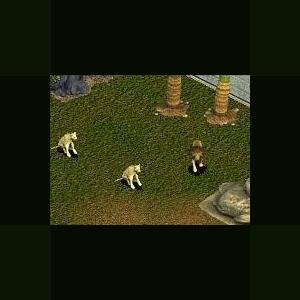About This File
Asiatic Lion by BigCatKeeper
The Asiatic lion was once widespread throughout Southwest Asia. Today the species can only be found in a single location in the wild, the Gir forest in India. Although genetically distinct from the sub-Saharan African lion, the difference is not large. In fact, the difference is less than that found between different human racial groups. The closeness in genetic make-up between Asiatic and African lions indicates that the two populations separated as recently as 100,000 years ago.
The most noticeable physical characteristic found in all Asiatic lions, but rarely in African lions, is a longitudinal fold of skin running along the belly. Also, the mane of the Asiatic lion is generally shorter than that of the African lion, so the ears are always visible. Asiatic lions are, in general, slightly smaller than African lions. Studies on Gir lions yielded the following figures: adult males weighed 160-190 kg, while adult females weighed 110-120 kg. The largest Asiatic lion on record measured 2.9 m from nose to tail-tip.
Like their African cousins, Asiatic lions are highly sociable animals living in social units called prides. There are however differences in pride make up between the sub-species. Based on the average number of adult females, the Asiatic pride is smaller. Studies have shown that most Gir prides contain just two adult females as compared to the average African pride which contains 4 to 6 adult females. The largest recorded female coalition of Asiatic lionesses is a group of five. However, it must be said that despite the small population and habitat area, few individual animals are known. Further field studies may show that what are currently identified as separate prides may actually be small foraging groups from larger prides. Adult male Asiatic lions exhibit a lesser degree of sociality than African males. Asiatic males only associate with the pride when mating or on a large kill. It has been suggested that this may be due to the smaller prey species available in Gir.
The most commonly taken prey are the chital and the sambar deer. However, domestic cattle have historically been a major component of the lions’ diet. This often leads to conflict between lions and humans. Despite the strong increase shown in the wild ungulate prey base a significant proportion of lion kills still consist of livestock. It should be noted that the ease of locating livestock kills compared to wild ungulate kills may distort the true proportion of wild/domestic kills. The availability of domestic livestock has also been put forward as another cause of the loose sociality of Gir lions.
The Asiatic lioness becomes sexually mature at 3 to 4 years old. In males sexual maturity is not reached until between 5 and 8 years. Females may come into season at any time during the year and give birth to litters of between 1 and 5 cubs. The average litter is 2-3 cubs. Both males and females may continue to breed up to 15 years old.
Approximately one-third of cubs die within their first year; this mortality rate falls to less than 10% for adult lions. In the Gir, females live on average for 17-18 years, but may live to 21 years; males, on average, live up to 16 years.
The range of this lion sub-species formerly stretched from northern Greece across Southwest Asia to central India. It became extinct in eastern Europe around 100 A.D., and in Palestine around the time of the Crusades. It remained widespread elsewhere until the advent of firearms in the mid 1800s led to widespread extinction. The lion had disappeared from Turkey by the late 1800s; the last reported sightings in Iran and Iraq date to 1942 and 1918 respectively. In India the lion came under heavy hunting pressure and by the turn of the century was restricted to the Gir forest.
The first census of lions in the Gir was conducted in 1936 and yielded a result of 234 animals, based on identification of individual paw prints (pug marks). Later censuses, using animal counts at live baits estimated the adult population at around 100 between 1968-1979. Censuses taken more recently, using live bait and waterhole counts, have indicated that the population is increasing steadily. A 1990 census counted some 221 adults living within the Gir Lion Reserve with a further 30-40 lions living in the surrounding agricultural areas. However, the accuracy of the waterhole counting technique has been questioned and substantially reliable results will not be obtained until individuals are marked.
Radio-telemetry studies have estimated the mean annual home range for male lions at 110 km², and females at 50 km². Male coalitions have ranges between 100-150 km² while single males have ranges of comparable size to that of females. Population density is estimated at one lion per 7 km², which would yield a total population of 202 adults, very close to the 1990 census result.
Created by Bigcatkeeper and LaWebtek [he did some programing]
Updated 2010-10-30
Just to save space with less in zip and smaller image.
Nothing new.



Recommended Comments
There are no comments to display.
Create an account or sign in to comment
You need to be a member in order to leave a comment
Create an account
Sign up for a new account in our community. It's easy!
Register a new accountSign in
Already have an account? Sign in here.
Sign In Now